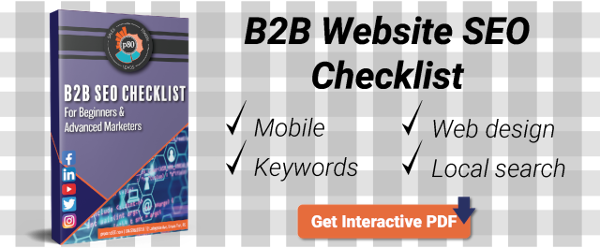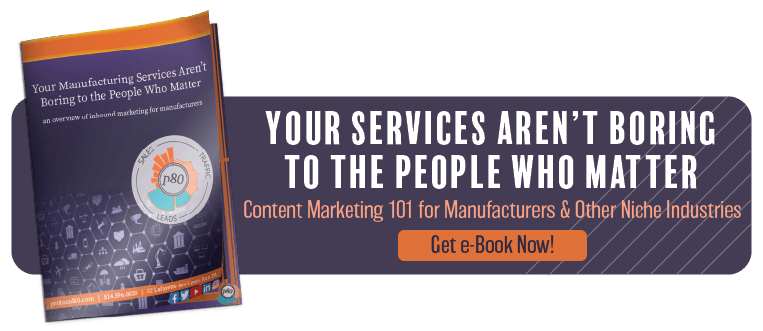Inbound Marketing Blog
for Manufacturers and Healthcare Companies
10 Challenges in Industrial Marketing B2Bs Still Struggle With in 2022

Today's challenges in industrial marketing are a bit baffling to outsiders. Why? There's really no reason they should still be a thing in 2022.
Especially during COVID, most industries became aware of not just the necessity, but also the power of owning a strong brand presence online.
There's no going back now -- those industries are using modern digital marketing approaches to give B2B buyers the experience they wanted all along.
But not the manufacturing industry ... for the most part, anyway.
Why? And how can you help change that? Here are 10 reasons manufacturers still struggle with marketing:
10 Totally Avoidable Challenges in Industrial Marketing
Today, at least 70% of buyers do their research online before approaching a vendor. With that in mind, these are the 10 marketing concepts holding B2B/industrial companies back in 2022:
- Longtime clients & stability
- Disconnect in goals
- Distrust of digital marketing
- Making it all about them
- Poor understanding of what their buyer wants
- No SEO
- Ancient website
- No (or false) in-house experts
- No clue what's working (and not)
- Spread too thin
1. Longtime Clients & Stability
We've worked with XYZ Company for 20 years!"
I can hear it coming out of a manufacturer's mouth now. While longtime clients that bring you steady operation and revenue are a good thing, overreliance can lead to being reactionary when it comes to marketing.
Many industrial companies in this situation have existed for 50-125 years and thus believe every potential customer already knows who they are. They do little to no marketing and ride the fraying coattails of the family or brand name legacy.
That's when you get this:
Oh, crap! One of our oldest clients just got bought out and isn't going to use us anymore! We need to fill that revenue and production hole! Let's start marketing!"
This isn't a great strategy, and it produces shoot-from-the-hip tactics that'll lack cohesion and effectiveness.
Marketing budget and buy-in also depends on ownership's motivation for growth. As we mature and get older, sometimes our hunger for growth is stymied. This can lead to less investment in marketing opportunities.
These businesses are near-impossible to find online if you don't already know who they are. This is a dangerous long-term path.
2. Disconnect Between Goals of C-Suite, Marketing, & Sales Teams
As is often the case, a sales person or the HR manager might be place in charge of getting the "website project" done. Their perspective on what the company needs to do and the perspective of the executives may clash completely.
To see where your company falls, look at the balance between sales and marketing, and how the executive team views it.
Sales-led organizations, naturally, tend to obsess over short-term end results -- like number of sales. This type of business mindset, where price is often a deciding factor, can limit the creativity and messaging of marketing efforts. It may also put the customer's true needs in the back seat.
Product- and customer-led organizations, however, focus on identifying and resolving a problem. They design solutions that don't just solve for now; they also prepare for customers' future needs. In today's digital-first world with long sales cycles, they have an easier time building B2B brand awareness and marketing narrative.
To summarize: There's a reason there are entire training courses dedicated to sales and marketing alignment. Without communication and consistent practices, a marketing and sales approach is going to lack focus and results.
 3. Distrust of Digital Marketing
3. Distrust of Digital Marketing
"Remember when we spent all that money on an advertisement in that digital trade magazine, and not a single lead came in the door!?!? Marketing doesn't work! Watch, I'll sew a nice banner with our logo to fly above our building. That'll get customers."
Running an ad one time in a trade magazine doesn't constitute marketing! To many B2Bs and manufacturers, though, that past failure leaves a bad enough taste in their mouths to minimally invest in marketing. So they continue to rely on field sales (How'd that work during COVID?) and outdated cold calling tactics.
While those tactics can still work in very controlled and specific uses, educating via content is far more likely to reach your ideal buyers. Did you know 80% of business decision-makers prefer to read a series of articles vs. an advertisement? Repeat after us:
- Yes, people read blog posts about "boring" industries
- Yes, people do open marketing emails
- Yes, niche/technical companies can grow revenue via LinkedIn & other social sites
Sadly, another problem in industrial selling is that even when supporters manage to convince the bosses to try inbound marketing, they still often end up tangled in red tape.
Here's one of many examples: Creating marketing materials that showcase authority is impossible without help from in-house SMEs -- subject matter experts. In industrial companies, these are usually the engineers, who tend to be tech-unsavvy and scoff at many fundamental modern marketing concepts. (For example, they see email marketing as "spam" and never use LinkedIn, and assume their customers think and act the same way.)
If this is how you, your engineers, or your decision makers feel, read this strictly results- and data-based article about the ROI of inbound vs. outbound (traditional) marketing.
If you take away nothing else from this article, take this: Your website needs educational content.
4. They Make It All About Them
We've hinted at it (just one sentence ago, actually). Now we'll come right out and say it.
Most industries have left behind the awful "Always be selling" principle and adopted the more customer-friendly "Always be helping." Once again, many B2Bs and manufacturers are behind the trend.
- Wonder why your website doesn't turn any traffic into leads?
- Wonder why nobody opens your emails?
- Wonder why your social posts get zero likes or clicks?
In all three cases, the answer is often the same: You made it all about yourself.
Ever-thirsty for the sale, too many companies make all their content marketing sound like thinly veiled sales pitches, with total disregard for the three stages of the buyer's journey. Remember that your "buyers" are researching a solution months -- if not years -- before they're actually ready to buy. Providing educational blog posts, videos, etc. will always work better than pushy or irrelevant content. (Nobody wants to read a blog post about your 2016 Christmas party.)
(Related Blog Post: How to write website copy that attracts ideal buyers AND gets you ranking in Google)
5. Don't Understand What Their Ideal Buyer Wants in 2022
When you're not sure how to attract your best buyers, you probably don't really know who they are in the first place. Documenting your B2B buyer persona(s) helps you target ideal accounts like a laser beam instead of a fire hose. That makes all of your marketing more effective, proactive, and ROI-focused.
Knowing your best buyers also means you know:
- Their pain points (which you'll create helpful content to solve)
- How they go about finding a solution (which tells you what social media platforms and keywords to target)
- Why they make a buying decision (which tells you what )
Laying this groundwork is a 100% must before you finalize and execute a marketing plan for your industrial/manufacturing company.
6. B2B SEO Is a Mystery
A beautiful and well-written website is useless if nobody sees it.
Nearly everything thinks they have a great writer on staff, or that they have a super-talented IT guy who can keep the website running smoothly. But has anyone bothered to audit your website's rankability in Google?
The work that makes this happen is called SEO (search engine optimization). SEO marketing often goes ignored by industrial decision-makers who either don't understand it, don't believe in it (probably because they don't understand it), or have never heard of it.
If your company's website hasn't undergone an SEO audit, find someone who can do it ASAP. An audit can identify:
- Keywords -- that you should be ranking for and writing content about
- Broken links & files -- which cause visitors to leave and Google to penalize you
- Tag issues -- page titles & descriptions need optimized so entice readers to visit your site
Search engine optimization has many components both external and internal relative to your website. They'll need ongoing maintenance, so check out our SEO checklist for the full list:
7. Website Is Functionally Ancient
Surprised it took so long to get to this?
Depending on your industry, your website's "razzle-dazzle" might not be as important as you think. While a nice-looking website is helpful (You DON'T want a homepage that's still not widescreen in 2022.), functionality is arguably more important.
If you improve the UX (user experience) of your website by following best practices, both your prospects and your sales team will thank you. How so, and what's that look like in practice?
- Navigation: Users should be able to easily find their industry, desired product, or educational content through logical linking and clean menus. Simple's usually better.
- Focus on conversions: Every page should have an endgame -- not just your RFQ and Contact Us pages. Pretty much every page should offer a lead-capture opportunity, like an e-book or a newsletter subscription.
- Speed: Another "Why is this happening in 2022?" plague of the manufacturing industry, site speed remains an issue. Use the SEO tips above to fix it.
- Mobile-friendliness: It's time to assume a good chunk of your readers are using a tablet or phone to research. Too many small and mid-sized B2Bs still offer mobile-unfriendly websites.
Just like with SEO above, you can't just build a website and never update it again. Success requires ongoing work.
8. No (or False) In-House Expertise
"It's time to revamp the website. Who wants to be in charge?"
Cricket ... cricket ... cricket ...
The reason no one volunteers is because no one is knowledgeable enough about it to make the project a success. Marketing takes more knowledge than which colors, fonts, and logos to use.
Sometimes you'll also see the false experts who think they've got everything under control. This could be due to ignorance or arrogance.
An example of ignorance:
"We just hired Johnny, my nephew. He took some computer classes in school and is all about that Facebook. He's going to get us on there too so we get more leads."
Uh-huh. While Johnny may know more about computers or Facebook than you do, it doesn't mean he knows how to build a B2B social media strategy for wastewater chemicals manufacturer.
Understanding what constitutes "marketing expertise" can also be an arrogance problem for leaders at manufacturing companies. Ever tried to perform an SEO audit? Neither has your team, probably. Swallow the medicine and hire in-house staff or a third-party agency that has experience in this. (The ROI will ease your pain.)
At smaller industrial companies, there's sometimes nobody on staff who even likes the art of marketing. It's usually dreadfully clear when that's the case, because most of the marketing materials are half-assed and wasteful.
9. No Clue What's Working and What's Not
"We spent $20,000 last year on social media advertising, PPC, radio ads, magazine ads, and marketing software. But we're not sure what worked and what didn't!"
That's no way to market, and a definite way to talk yourself out of inbound industrial marketing. Doing it correctly means planning how you'll measure effectiveness and actively reviewing ROI.
When manufacturing marketers fail to immerse themselves in the data regularly, they tend to make irrational or uninformed decisions that delay or derail the original plan. Then that happens, your digital marketing campaign grows more slowly on all fronts.
As an industrial marketer, be open to new tools:
- SEO tools
- CMS (content management system software)
- CRM (customer relationship management) software
These all help you see what keywords you're ranking for, which topics are bringing traffic and leads, and, how your strategy should adapt (but only after a deliberate and data-influenced review).
10. Spread Too Thin
There're a million tasks to choose from, and the ones that directly contribute to money coming in the door (e.g., production, operations) tend to be the focus.
If you think marketing can/should always be directly tied to money coming in the door, your strategy will fail to account for a huge percentage of potential leads out there. This is when we often see marketing get back-burnered until it's a necessity (see Challenge #1 above).
This issue is a simple matter of investing more time and staff in SEO and content marketing. You may also need to devote more money up-front, but inbound industrial marketing agencies tend to pay for themselves quickly. (And so can in-house hires, as long as you don't expect one person to have time/knowledge to do everything.)
If the resource above didn't convince you of inbound marketing's ROI, try this ThomasNet article about cost per acquisition.
Conquer Your Challenges in Industrial Marketing
There's a lot going wrong with industrial marketing strategies, but it is getting better. And look at the positives -- since many industrial companies are lagging in website and content marketing, the bar is low! Just getting started can help you beat your competitors in Google and be seen as the superior authority for your product/service.
Speaking of getting started, here's one last resource -- an 101-level guide to how niche marketing works in the B2B space. Show it to your salespeople and bosses, and proclaim content marketing as the best thing ever (or at least something worth investigating):
(Editor's note: This article was originally published in August 2015 and was recently updated.)
Our Blogs, Direct to Your Inbox!
How to Audit your Online Marketing
If you are executing digital marketing, congratulations! You are most likely already one step ahead of your competition, and making strides to meaningfully connect with prospects online. But, how do you know if you’re seeing continual success year over year, and improving your metrics?
Without the tools in place to analyze and benchmark your efforts, it is impossible to scale your online marketing and ensure continuous success.



